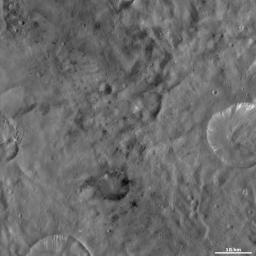This Dawn framing camera (FC) image of Vesta shows Laelia crater, which is the crater with dark material inside of it and surrounding it in the bottom center of the image. The dark material inside of Laelia crops out from the rim and then slumps towards the crater's center. The dark material outside of Laelia is dominantly associated with smaller impact craters that are less than 1 kilometer (0.6 mile) in diameter. One spectacular small, dark material crater is located to the bottom right of Laelia and has an impressive pattern of dark material ejecta rays extending from it. More small impact craters with dark material ejecta are located above Laelia crater in this image.
This image is located in Vesta's Sextilia quadrangle, in Vesta's southern hemisphere. NASA's Dawn spacecraft obtained this image with its framing camera on Oct. 13, 2011. This image was taken through the camera's clear filter. The distance to the surface of Vesta is 700 kilometers (435 miles) and the image has a resolution of about 68 meters (223 feet) per pixel. This image was acquired during the HAMO (high-altitude mapping orbit) phase of the mission.
The Dawn mission to Vesta and Ceres is managed by NASA's Jet Propulsion Laboratory, a division of the California Institute of Technology in Pasadena, for NASA's Science Mission Directorate, Washington D.C. UCLA is responsible for overall Dawn mission science. The Dawn framing cameras have been developed and built under the leadership of the Max Planck Institute for Solar System Research, Katlenburg-Lindau, Germany, with significant contributions by DLR German Aerospace Center, Institute of Planetary Research, Berlin, and in coordination with the Institute of Computer and Communication Network Engineering, Braunschweig. The Framing Camera project is funded by the Max Planck Society, DLR, and NASA/JPL.
More information about the Dawn mission is online at http://www.nasa.gov/dawn and http://dawn.jpl.nasa.gov.

 Planetary Data System
Planetary Data System












